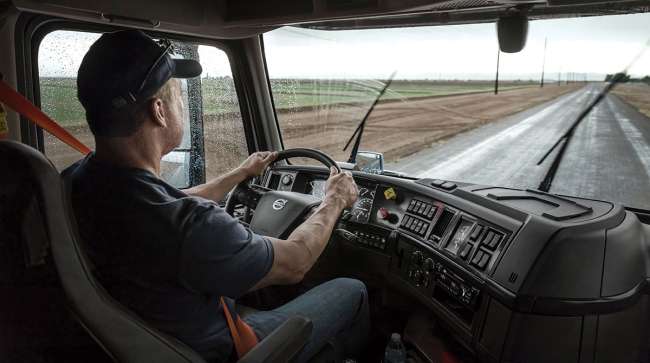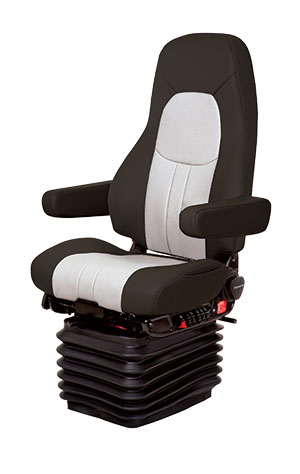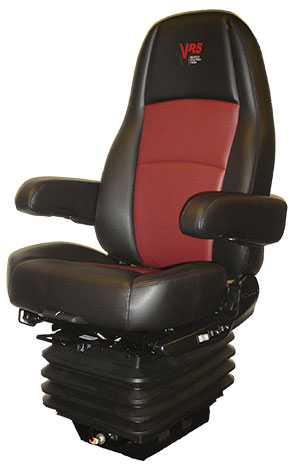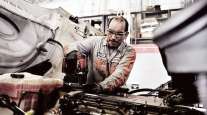Fleets, OEMs Invest in Seat Technology to Improve Driver Comfort, Safety

[Stay on top of transportation news: Get TTNews in your inbox.]
Since truck drivers spend so much of their professional lives sitting behind the steering wheel, the driver’s seat is a crucial part of the vehicle spec.
The latest truck seats now offer increased adjustability, advanced materials and more effective suspension to increase driver comfort. Higher-end cab comfort is also a perk advertised by fleets to attract and retain drivers.
“The last thing we want to do is lose a driver over an uncomfortable seat,” said Kyle Neumann, maintenance director for food-grade bulk carrier Foodliner. “Drivers aren’t bashful. If they’re uncomfortable, they’re going to let you know. That has driven us to constantly look at seats and make sure we’re staying ahead of the curve, so we’re giving them the best option that is out there.”

The latest truck seats now offer increased adjustability, advanced materials and ore effective suspension to increase driver comfort. (National Commodore)
Seat design has evolved, said Sandeep Premkumar, chief technical engineer for human factors and ergonomics at truck maker Navistar.
“We now have more objective and subjective data around seat discomfort, seat materials have changed, new testing equipment/methods are being developed, seats have gotten better at isolating road inputs and new functions have been added to seats,” he said.
Science and engineering are the dominant forces behind the new designs, said John Duax, director of the North American aftermarket business for Sears Seating.
“Not only does the seat have to be comfortable to the driver, but there also has to be some science behind it to eliminate a couple major issues prevalent in trucking for years — driver’s fatigue and lost time due to injury,” he said.
Less-than-truckload carrier A. Duie Pyle specs premium seats to help improve safety.
“If I have a poor seat, it can lead to back injuries,” said Dan Carrano, vice president of fleet maintenance for the West Chester, Pa.-based fleet.
Carrano said lumbar support and adjustability are critical to comfort, but adjustments were limited in the past.

Q3 Calibrate Stories
►Frequent Overhead Maintenance: Worth the Trouble?
►Volvo, Bendix Team Up on Safety, Training
►Menig: Technology Solutions for Trailers
►Freeze: Introducing Calibrate
“You just had the air that would raise and lower the seat and the seat slide to move it up and back,” he said, adding that now the seat base can be adjusted to make it longer, and there is a tilt on most seat bottoms. “Between the length of the seat cushion, the tilt of the seat cushion and the lumbar support, the adjustability is pretty drastic.”
A. Duie Pyle, which ranks No. 69 on the Transport Topics Top 100 list of the largest for-hire carriers in North America, also specs armrests to increase comfort. Carrano said the armrests help support a driver’s shoulders and arms and prevent arm and neck strains.
Adam Lindloff, aftermarket sales manager at Seats Inc., said the company’s high-end seat, the Pinnacle, offers about 8 million positions when considering every possible adjustment. Plus, drivers can adjust the seat without removing their weight.
However, drivers may not always realize the extent to which they can make those adjustments.
“You would think people know how to adjust their seat correctly, but they don’t always,” said Gary Hamberg, a vice president at New Albany, Ohio-based Commercial Vehicle Group, which manufactures National Seating and Bostrom brand seats.
Foodliner’s Neumann said Sears Seating has sent representatives to address driver concerns.
“They may find out that maybe the seat just wasn’t adjusted for the size of the driver,” he said.

Could this be the trucking industry’s roaring '20s? Business is booming, thanks, in part, to a slew of innovative technologies. With host Mike Freeze, we begin to wonder what’s next? Hear a snippet above, and get the full program by going to RoadSigns.TTNews.com.
Foodliner, together with its sister company Quest Liner, ranks No. 76 on the TT Top 100 list of for-hire carriers.
Lindloff said the wide range of drivers’ body types and the increasing number of women entering the trucking industry has made ease of adjustability more important.
“Female drivers have complained they can’t get up high enough to see over the hood,” he said. “You can change the rake angle, which increases the hip point where the occupant is sitting. You’re sitting higher, but the position isn’t interfering with you getting to the pedals.”
Daimler Trucks North America’s proprietary seats offer air lumbar adjustment, cushion extensions, tilt and adjustable shocks, and optional heating and ventilation through the seat base, said Ryan Major, DTNA’s on-highway segment marketing manager.
The evolution of ergonomics
Cushion width and firmness, fore-aft and up-down travel ranges, and seat suspension design are all key elements of a seat that better accommodates the inherent variability in the sizes and postures of drivers, Premkumar said.
Historically, much of the emphasis on commercial vehicle cab design has been on physical ergonomics, which deal with the physical load on the human body.
“Macro trends such as automation, electrification and connectivity are driving a lot of new technology into cabs and introducing new ways for drivers to interact with vehicles,” Premkumar said, adding that cognitive ergonomics is gaining prominence.
Navistar is focusing on addressing drivers’ emotional, cognitive and physical needs, which starts with identifying critical product attributes that impact the overall experience, analyzing user needs, capabilities and limitations, and then specifying performance targets for critical attributes.
CVG has worked to improve seat performance through suspension.
“It takes the load and the inputs from the road, so it doesn’t get through to the driver,” Hamberg said. “There are a lot of new technologies with dampers that can automatically adjust the properties of the components based on the inputs coming in from the road.”
Truck drivers operate in a high-vibration environment.
“The best defense can be found in a properly fit seat that removes vibration and increased comfort for the driver’s particular needs,” said Jennifer Ross, director of business development for Seat Specialists.
Short-term exposure to extreme whole-body vibration can result in muscle fatigue, discomfort, headaches and motion sickness, while long-term exposure can result in spinal disc disease, sciatic pain and lower back pain and can ultimately shorten a driver’s career, Duax said.
Air suspended seats enable support for varying road conditions, said Allison Athey, product marketing manager at Volvo Trucks North America.
“There are several other seat features for added comfort that Volvo Trucks offers like a swivel base, adjustable seat shock absorber, memory with quick air release and back cycler massager, in addition to a passenger seat with refrigerated storage,” she said.
Ross said Seat Specialists’ suspensions can be low or standard, which basically defines the amount of travel up and down in the seat and their starting position.

New developments in foam allow the Atlas II Active VRS Suspension seat to keep its structure longer. (Atlas)
The Atlas II Active VRS Suspension seat incorporates an active magnetic ride suspension system.
Duax said the Sears Active VRS lowers the driver’s exposure to whole-body vibration by 32%, up to 65% better than the average passive suspension seat during a normal shift.
New developments in foam allow it to keep its structure for longer, Ross said. She added that the most important aspects of the material are breathability, friction and durability. There are also many comfort features, such as lumbar, massage and heat, that can all contribute to comfort, she said.
Hamberg said heating and cooling technology in seats is advancing.
“It is more prevalent in automotive, and it is becoming more requested in the trucking market,” he noted.
The advance of automated driving technology is influencing seat features, and sensors can ensure drivers stay seated.
“You have to safeguard for that, but you also have to get it where they can get to a more comfortable position while still being able to get ahold of the steering wheel,” Hamberg said.
DTNA introduced a sensor in the seat base when introducing its Active Lane Assist feature, which provides active steering assistance for the driver.
“If the operator were to have a health event and fall out of the seat for some reason, the ALA system can take action to help prevent an accident,” Major said.
Vehicles are getting quieter, which means seat noise becomes more obvious, Hamberg said.
“When the electric vehicle market kicks in, they will be even quieter. One area we spend a lot of time on is noise,” he said.
Because cab comfort is so essential, A. Duie Pyle keeps complete seats and seat components in stock to make repairs quickly. “If a driver writes up a seat, we’re quick to address that,” Carrano said. “It isn’t just comfort. We know it could lead to other issues like retention or safety.”
Want more news? Listen to today's daily briefing below or go here for more info:




